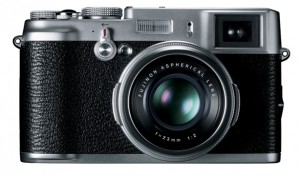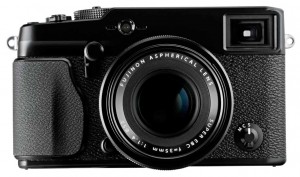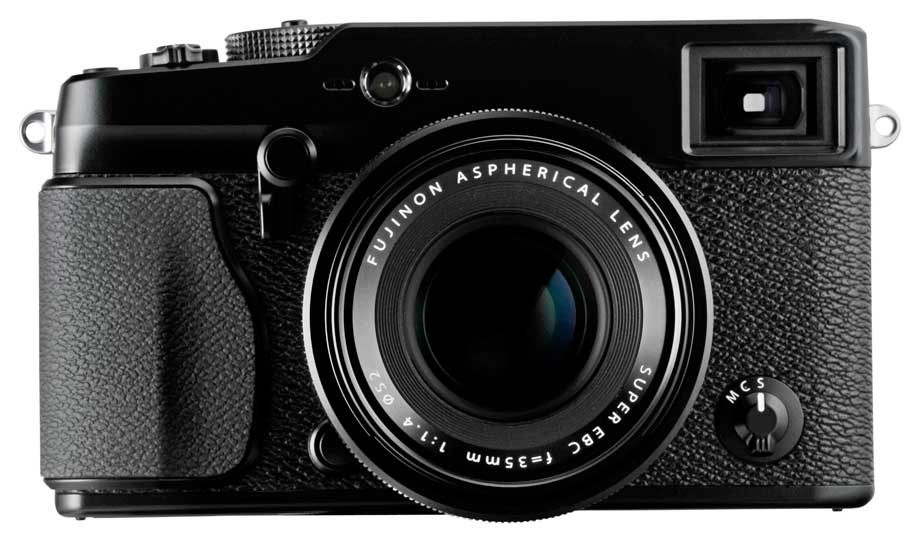Fuji X-Pro1
An interesting trend has emerged during this whole mirrorless craze. People are going gaga for retro designs. It started with the Olympus E-P1…a classically styled stainless-steel body that exuded the feel of a 1960s Olympus Pen F. Despite the retro look, it remained functional. Then Fuji got involved, and the whole retro trend took off.

When Fuji released their X100 camera, the photography world gasped. It had classic styling, a return to knobs and dials and even a functioning aperture ring. It looked like a classic Leica M rangefinder, yet incorporated an amazing image sensor and a revolutionary new hybrid viewfinder that combined a rangefinder-like optical viewfinder with electronic overlays, as well as the ability to switch entirely to a through the lens electronic finder. The lens is a fixed 24mm f/2, yielding a field of view similar to a 35mm lens on a full frame body, which is a good length for many photographers for street shooting or general photography.
This classic sense of design, with switches and dials and knobs, struck a chord with photographers young and old. It harkened back to what was great about simple mechanical film cameras, yet incorporated the latest technology. Perhaps the biggest success is the outstanding sensor that Fuji incorporated into the X100. It is a very high performing camera, with outstanding color and fantastic high ISO capability. The camera has been very successful, despite a number of flaws. Originally, the autofocus had serious issues with speed and ability to find focus in dim light. A later firmware update fixed some of these issues, but it still isn’t as fast or reliable as the modern mirroless system cameras. Additionally, manual focus is spotty.
Still, the sentiment among many photographers is that they wanted an interchangeable lens system based around the X100. A top tier sensor, classic functional design and great lenses, combined with a wonderful viewfinder and (hopefully) autofocus that matches other mirrorless cameras.
At the Consumer Electronics Show 2012, Fuji announced their X-Pro1, a new camera with old-school design, interchangeable lenses and a great sensor. Would this be the camera that sets the bar, that best combines performance, size and image quality? The market will have to decide, but in my opinion, the answer is no.

The X-Pro1 has a number of extremely desirable features. It’s got a classic design, similar to the X100, with shutter speed dials, aperture rings on the lenses and the same hybrid viewfinder that people loved in the X100. Additionally, Fuji released three lenses that really appeal to the pure photographer in me. With the X-Pro 1, Fuji announced three lenses: 18mm f/2, 35mm f/1.4 and 60mm f/2.4 macro.
I love a lot of Fuji’s choices here, appealing to advanced photographers with a ‘holy trinity’ of prime lenses, rather than bundling a slow 28-80 equivalent zoom lens. The lenses look to be of very good quality, and image quality samples show the sensor to be outstanding, with wonderful tonal range and good high ISO capability. The sensor is 16 megapixels, but that resolution is plenty for 99% of photographers, and is capable of making excellent 20×30″ prints. Additionally, to my eyes there is a richness to the files that is very unique. It’s a truly beautiful rendering with wonderful color, a soft and gentle contrast rolloff and a depth that I frankly have rarely seen before.
However, in my opinion Fuji fell far short of perfect with this offering, and my hope is that they will be able to remedy many of the issues I have with their next few cameras. First, the body is quite overpriced. Fuji is asking $1700 for this camera, and this might be worth it, except that Sony has their excellent NEX-7 priced a full $500 below that for a 24 megapixel APS-C option with an amazing viewfinder.
Second, the X-Pro1 has these retro design elements, but for a premium product made some interesting design choices. The aperture ring on the lenses is electronic, as is the focus. While focus-by-wire can be very good if implemented well, early reports are showing manual focus to be less than ideal on the X-Pro1, and for a premium ‘retro’ product, having no mechanical coupling on these controls is an odd choice.
Thirdly, the viewfinder that worked so well on the X100 doesn’t work nearly as well on a camera like the X-Pro1. It has a typical rangefinder style, which superimposes frame lines on the view. This works quite well for wide-angle lenses and normal lenses, but starts to become less advantageous for lenses that start getting towards telephoto. Yes, you can switch to EVF for these lenses, as I’m sure most will do, but the EVF isn’t quite up to the level of the competition.
In addition to these issues, early hands on videos show that the autofocus still lags the competition by a significant margin, including some failure to lock focus in average light, even with contrasty subjects. The speed is also a step behind Micro 4/3, Nikon 1 and NEX. This might not be a problem if manual focus were implemented well, which unfortunately it isn’t. The focus by wire is being reported to be less than precise, with the viewfinder not offering focus peaking or a decent viewfinder magnification for precise focus. This is a letdown to photographers who were looking for a more affordable body to put their Leica M rangefinder lenses on.
The biggest thing for me, and this might be less important for other photographers, is that the body is just too big. It’s significantly larger than any of the other mirrorless systems out there. If this had been released about 5 years ago, the size would have seemed better in line, but now that we have outstanding mirrorless options the size of the Panasonic GX1 or the Sony NEX-7, a body this size is less desirable to me. See the following links for comparison to the Panasonic GX1 or the Sony NEX-7. Some photographers might still find it small, as it’s roughly the same size as the Leica M9, but compared to the competition, it’s a chunky brick of a camera. The lenses are of decent size, but at its smallest, the system becomes far less portable than the competition. With all of these issues, the Fuji X-Pro1 is a case of Close, but No Cigar, at least for me.
Next, the Olympus OM-D and what it all means:






Leave a Reply